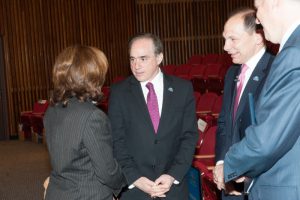Dr. David Shulkin, announced today as President-elect Donald Trump’s pick for Secretary of Veterans Affairs, was a resident at the University of Pittsburgh School of Medicine. In its Winter 2016 issue, Pitt Med Magazine gave a peek into Shulkin’s time at Pitt. The article below was written by Nick Keppler.

The VA’s Under Secretary for Health, David Shulkin (center) and VA Secretary Robert McDonald (flanking him on the right) visited Pitt in November 2015. Credit: Mike Drazdzinski/CIDDE.
General medicine residents spend their days seeing patients, mastering clinical skills, absorbing a ton of information, and developing a bedside manner. When David Shulkin (Res ’89, Fel ’90) trained at Pitt, he also spent a lot of time going through stacks of file folders.
Shulkin, who had followed his wife-to-be, Merle Bari (Res ’90), to Pitt, where she pursued her dermatology residency, asked his advisors to allow him to study care costs at insurer Blue Cross of Western Pennsylvania. It was the first time a resident had made such a request, Shulkin recalls. “They were amazingly open to allowing me to explore my interests and my desire to understand how [the business of ] health care works.”
Shulkin would go on to manage huge health care systems, including one of the nation’s largest: the U.S. Department of Veterans Affairs.
That early Pittsburgh study on health care costs was so fascinating and promising, Shulkin stayed on an extra year as a general medicine fellow to complete the project
His findings, published in the Annals of Internal Medicine and covered on the front page of the Pittsburgh Post-Gazette, showed that doctors largely had no knowledge of the cost of the care they provided. This was leading to the rise of a managed care industry to keep costs in check—yet the increase in administrative costs was also raising the price of health care. “We were at the beginning of a trend showing health care costs were set to explode,” he recalls, “and as we now know, that’s become a fundamental issue in health care design.”
Shulkin would later spend four years as president and CEO of New York’s Beth Israel Medical Center and serve as the president of the New Jersey–based Morristown Medical Center. He also founded DoctorQuality, an early informational Web site for health care consumers.
In 2015, Shulkin became the VA’s under secretary for health. (President Obama nominated him in March, and the Senate confirmed him in June.) The VA is a behemoth of a health care system: Its annual budget is $59 billion; the system employs 300,000 people; and it stretches across more than 1,500 facilities. As if that isn’t enough of a challenge, Shulkin is taking the helm at one of the most difficult times in the department’s history. In June 2014, 35 veterans died waiting for care from the VA system of Phoenix. Subsequent investigations by several government agencies showed the system was buckling under increased demand for care. Nationwide, about 57,000 patients were waiting for appointments, and VA facilities had kept secret waiting lists and falsified data. The scandal led to the resignation of Secretary of Veterans Affairs Eric Shinseki and the early retirement of Shulkin’s predecessor, Robert Petzel.
As part of the VA’s new leadership, Shulkin says he is walking a balance between implementing reforms and helping VA employees keep their chins up in light of a difficult job and public scrutiny. “The morale at the VA today is not where it needs to be,” he says. “It’s demoralizing to work as hard as I know our employees work and not be recognized for that work.”
He says his other key goals are ensuring that every veteran who needs immediate care gets it and that others are seen within 30 days or are given the option to see a privatesector provider. (The latter is an option provided by the Veterans Access, Choice and Accountability Act of 2014.)
Shulkin still credits that unusual residency rotation at Pitt and the advisors who signed off on it with his position in the VA.
“If it wasn’t for the experience they allowed me to have, to be different from the typical resident, I’m not sure I would be where I am today.”








